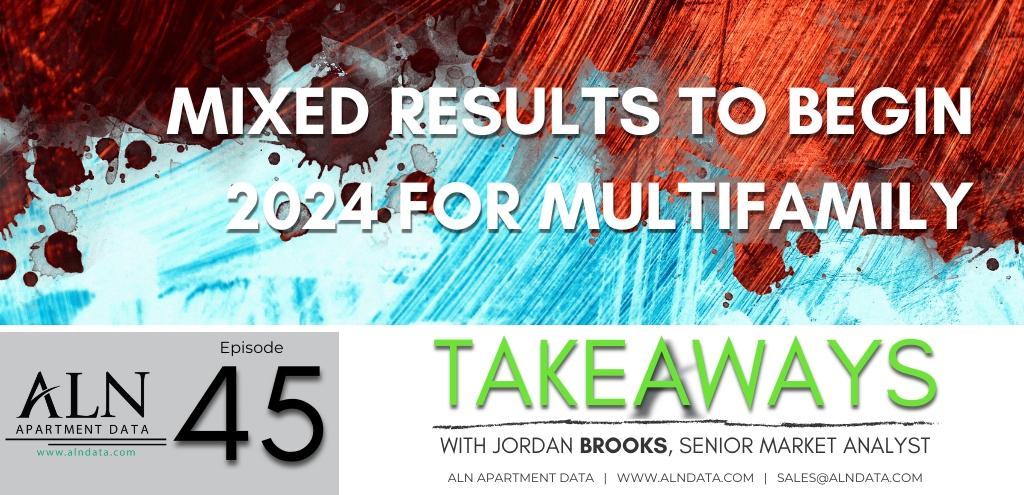Apartment Demand Improved in August
After struggling earlier in the summer, national net absorption took a major step in a positive direction in August. The improvement was a welcome sight with the fall and winter months quickly approaching. By this time last year apartment demand had already disappeared, and August of 2022 was the first of five consecutive months in which national net absorption was negative. All numbers will refer to conventional properties of at least fifty units.
The Summer Rollercoaster
Earlier this year, it appeared that the usual seasonality in apartment demand that had been absent in the 2020 through 2022 was reemerging. Sluggishness in January and February was followed by some improvement in the March through May spring period. Net absorption expectations coming into 2023 were for a fairly muted outcome, but early in the year it seemed that 2023 might at least represent something of a return to normalcy from the perspective of seasonality.
However, after steady improvement through the spring period – the summer months were throwing a wrench into that theory. National net absorption totaled less than the approximately 28,000 net units from May in June and July combined. It is not uncommon for May to be the highwater mark of monthly demand in a given year, but the considerable decline in the summer months was unusual. As a result of the summer doldrums, national net absorption through July was underperforming even last year’s dismal results. The spring months were in position to end the year as the most robust demand period of 2023.
Enter August. Net absorption of just more than 40,000 units was the most for any month since October of 2021. The August result was enough to push the June through August period past the March through May period for national demand – making the summer months the likely highpoint of the year. The improvement was enough for national average occupancy to remain unchanged in August after twelve straight months of declines and the demand jump came without a decline in the average effective rent.
Market Notes
An interesting mix of markets were among those that saw monthly net absorbed units improve the most from July to August. In Atlanta, just less than 2,000 net absorbed units in August followed July in which net absorption had been slightly negative and the month-over-month improvement was by more than 2,100 net units. August net absorption in Los Angeles was just over 2,100 units – a 2,000-unit improvement from July.
Other markets with considerable month-over-month improvement included larger markets like Miami, St. Louis, New York, Denver, Washington DC, and Raleigh – Durham along with smaller markets like Birmingham and Columbus.
August was not a tide that lifted all boats, however. A majority of markets around the country saw improvement from July, but some took a step back. Chicago was in a category of its own. A net loss of more than 200 leased units meant that monthly net absorption for August was a little more than 2,000 units lower than the July total. In Detroit, a net loss of nearly 200 leased units represented an underperformance of almost 900 net absorbed units from the prior month. And in Albany, August net absorption was negative by more than 300 units – a shortfall of more than 800 net absorbed units from July.
Other areas that particularly struggled relative to July demand included Nashville, Cleveland – Akron, Reno, San Diego, and Springfield. In all, nearly 40% of markets took a step back in August from their July net absorption total.
Takeaways Episode 45
Takeaways
National net absorption is August was encouraging within the context of the earlier summer struggles. The best national monthly total in nearly two years is nothing to sneeze at. And yet, not all is roses. An obvious caveat is that one data point does not make a trend. But with that aside, there are a couple of other relevant points.
For one, the dramatic improvement in August was more driven by strong improvement in a dozen or so markets than it was a widespread phenomenon. This is evidenced by about 40% of markets actually underperforming July in August, but also another two dozen markets that saw improvement in August of less than 100 net absorbed units.
The year has already proven to have some abnormalities from a seasonality perspective, but in broad strokes – more typical seasonality has been the story. It is true that June and July were unusually soft for apartment demand but zooming out – we now have a year in which demand was slow in the first couple of months before picking up in the spring period and then improving further in the summer period when taken as a whole. The path to that result was not quite typical, but the result is. It seems reasonable then to expect something resembling normal seasonality in the fall and winter period of this year while acknowledging the real possibility of some further inconsistency.
With macroeconomic headwinds remaining, student loan repayments set to begin next month, and the traditionally softer fourth quarter approaching – the pleasant surprise provided by August apartment demand was a most welcome one and it will play an important role in the final 2023 annual absorption figure.
Click here to setup a webinar if you would like any information on the data we provide.
Disclaimer: All content and information within this article is for informational purposes only. ALN Apartment Data makes no representation as to the accuracy or completeness of any information in this or any other article posted on this site or found by following any link on this site. The owner will not be held liable for any losses, injuries, or damages from the display or use of this information. All content and information in this article may be shared provided a link to the article or website is included in the shared content.


